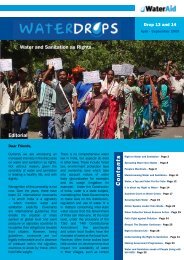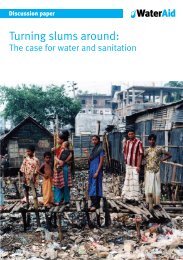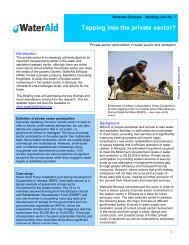Measuring sanitation: Outcomes as well as outputs - WaterAid
Measuring sanitation: Outcomes as well as outputs - WaterAid
Measuring sanitation: Outcomes as well as outputs - WaterAid
You also want an ePaper? Increase the reach of your titles
YUMPU automatically turns print PDFs into web optimized ePapers that Google loves.
Discussion paper<br />
Paper written by<br />
James Wicken,<br />
<strong>WaterAid</strong>’s<br />
Regional<br />
Advocacy and<br />
Policy Advisor in<br />
Asia<br />
September 2008<br />
<strong>Me<strong>as</strong>uring</strong> <strong>sanitation</strong>:<br />
<strong>Outcomes</strong> <strong>as</strong> <strong>well</strong> <strong>as</strong> <strong>outputs</strong><br />
<strong>WaterAid</strong> / Juthika Howlader<br />
This rural community in North-western Bangladesh maps out existing facilities in the<br />
village to ensure everyone h<strong>as</strong> access to a hygienic latrine.<br />
Headlines<br />
• Poor <strong>sanitation</strong> h<strong>as</strong> a profound impact on child mortality in<br />
particular and public health and <strong>well</strong>-being in general<br />
•<br />
Health impacts are maximised when the outcome of a <strong>sanitation</strong><br />
programme is a community or jurisdiction where no-one is exposed<br />
to the risks of indiscriminate disposal of human excreta: a zero<br />
excreta environment<br />
<strong>WaterAid</strong>’s mission<br />
is to overcome<br />
poverty by enabling<br />
the world’s poorest<br />
people to gain<br />
access to safe water,<br />
<strong>sanitation</strong> and<br />
hygiene education.<br />
• Countries should report on commitments made at SACOSAN 2 to<br />
new indicators and agree to introduce two new indicators and report<br />
on progress at future SACOSANs:<br />
1. the number and proportion of zero excreta jurisdictions in a<br />
country<br />
2. the rate of diarrhoeal dise<strong>as</strong>e
Introduction<br />
There is an old truism that says ‘you get what you me<strong>as</strong>ure’. What this means is that delivery<br />
mechanisms have a tendency to adapt themselves to deliver what is being me<strong>as</strong>ured. This is<br />
happening in the <strong>sanitation</strong> sector where access to improved infr<strong>as</strong>tructure is being used <strong>as</strong> an<br />
indicator. As a result, millions of latrines are being constructed that may or may not be leading to<br />
improved sanitary outcomes and health benefits.<br />
At the second SACOSAN conference held in Islamabad in 2006, countries in the region committed<br />
to work together to identify a new set of indicators for <strong>sanitation</strong> and use these to report on<br />
progress at the next SACOSAN to be held in India in 2008. 1 This paper h<strong>as</strong> been prepared <strong>as</strong> a think<br />
piece for consideration by governments and stakeholders working on possible indicators.<br />
What are we me<strong>as</strong>uring for <strong>sanitation</strong> and what are we getting?<br />
The Millennium Development Goals (MDGs) and Joint Monitoring Programme utilise household<br />
survey data on access to improved infr<strong>as</strong>tructure <strong>as</strong> a proxy for sanitary status. Using this<br />
indicator, the latest coverage data for South Asia is reported to be 33% (UNICEF and WHO 2008).<br />
Millions of latrines are being constructed across South Asia each year and yet there are doubts<br />
about whether all these latrines continue to meet minimum hygienic criteria and whether they are<br />
being used all the time. This phenomenon h<strong>as</strong> been termed ‘latrinisation’, which means<br />
infr<strong>as</strong>tructure creation without sustainable behaviour change. It h<strong>as</strong> emerged in part due to the<br />
numerical nature of the MDGs and national <strong>sanitation</strong> targets.<br />
While it is important for governments and international organisations to continue to monitor access<br />
to improved infr<strong>as</strong>tructure, access alone does not automatically translate into health<br />
improvements. New evidence suggests that both the <strong>as</strong>sociated dise<strong>as</strong>e burden and the impact on<br />
economic development of poor <strong>sanitation</strong> is far greater than previously estimated (<strong>WaterAid</strong><br />
(2008), WHO (2008), World Bank (2008)).<br />
What we should me<strong>as</strong>ure…<br />
‘Sanitation’ means more than just having access to a latrine. Sanitation encomp<strong>as</strong>ses excreta<br />
disposal, solid w<strong>as</strong>te and w<strong>as</strong>te water management and hygienic practices. Therefore, <strong>sanitation</strong><br />
monitoring systems should strive to cover all these <strong>as</strong>pects. However, <strong>as</strong> a starting point, this<br />
paper is proposing indicators that me<strong>as</strong>ure progress in tackling the highest risk elements of poor<br />
<strong>sanitation</strong> ie. unconfined excreta.<br />
…and why<br />
• Safe <strong>sanitation</strong> is not only access to a latrine: Given a tradition of ‘open defecation’, access<br />
to a toilet does not always mean use of a toilet.<br />
• Safe <strong>sanitation</strong> is not only use of a latrine: Unsanitary latrines (those that fail to confine<br />
excreta) may pose a greater health risk than ‘open defecation’.<br />
• Safe <strong>sanitation</strong> is not only use of a sanitary latrine: The hygienic use (ie. handw<strong>as</strong>hing) and<br />
maintenance of a sanitary latrine (ie. emptying) affects the exposure of individuals to<br />
excreta.
• Safe <strong>sanitation</strong> is not only the hygienic use and maintenance of a sanitary latrine: The<br />
sanitary behaviour of an individual is often compromised by the unsanitary behaviour of<br />
others.<br />
• Safe <strong>sanitation</strong> is the safeguarding of an environment free from unconfined excreta –<br />
termed here <strong>as</strong> a zero excreta community or jurisdiction. The public nature of this desired<br />
outcome necessitates a change in the collective sanitary behaviour of individuals.<br />
Moving from output to outcome and impact indicators<br />
The successful outcome of <strong>sanitation</strong> should be indicated by a zero excreta environment; an<br />
environment where the community or jurisdiction h<strong>as</strong> completely eradicated the risks posed to all<br />
of its inhabitants by the indiscriminate disposal of human excreta.<br />
Governments, donors, non governmental organisations and communities should begin to count<br />
and report on the number and proportion of zero excreta jurisdictions (in addition to the<br />
percentage access to latrines). This offers a collective indication of sanitary progress which takes<br />
<strong>as</strong> its goal the requirement that the poorest and most vulnerable must be living in a sanitary<br />
environment.<br />
Improved <strong>sanitation</strong> is expected to result in reduced diarrhoeal dise<strong>as</strong>e and mortality. Data on<br />
diarrhoeal dise<strong>as</strong>e and mortality are collected by governments and international organisations,<br />
normally in the health sector, and yet are not regularly reported or used by the <strong>sanitation</strong> sector.<br />
It is proposed that governments include diarrhoeal dise<strong>as</strong>e incidence in <strong>sanitation</strong> sector reporting.<br />
Comparing this data with trends on <strong>sanitation</strong> access (<strong>outputs</strong>) and zero excreta are<strong>as</strong> (outcomes)<br />
will provide a b<strong>as</strong>is for analysis and discussion on how to ensure <strong>sanitation</strong> results in health<br />
benefits for all members of a community. Collaborative reviews of these data by the <strong>sanitation</strong> and<br />
health sectors will provide a starting point for incre<strong>as</strong>ingly integrating <strong>sanitation</strong> within the health<br />
sector. Diarrhoeal incidence data could also serve <strong>as</strong> a useful criterion for allocation of priority and<br />
resources for <strong>sanitation</strong> interventions <strong>as</strong> a proxy for poor <strong>sanitation</strong> status.<br />
Why make this shift?<br />
Collecting and reporting on these indicators will give a true picture of the extent of progress in<br />
achieving universal access to <strong>sanitation</strong>. It will also ensure inclusion of the poorest and most<br />
vulnerable people and communities in <strong>sanitation</strong> progress. Finally, it will realise the expected<br />
health gains from improved <strong>sanitation</strong> by incentivising governments, service providers and<br />
communities to strive for community level <strong>sanitation</strong> outcomes.<br />
Call to action<br />
Governments in South Asia have committed to universal <strong>sanitation</strong> access, exceeding the MDG<br />
targets. We call on governments to take another step towards turning this commitment into reality<br />
by reviewing progress on SACOSAN 2 commitments to reporting on a new set of indicators and by<br />
embedding outcome and impact indicators into monitoring systems and using these for regional<br />
reviews of progress at SACOSAN 4 and beyond.
Acknowledgements<br />
Special thanks to Mark Ellery, Water and Sanitation Programme (WSP) Pakistan, for collaborative<br />
inputs in conceptualising and writing of this discussion paper.<br />
Notes<br />
1<br />
The Islamabad declaration, signed by all governments in the region in 2006, states: “We further<br />
reaffirm at Islamabad to accelerate progress for achievement of adequate <strong>sanitation</strong> delivery<br />
systems in a planned and ph<strong>as</strong>ed manner by […] discussing progress on all <strong>as</strong>pects of <strong>sanitation</strong> on<br />
a regular b<strong>as</strong>is by reporting at the next South Asian Conference on a common set of indicators to<br />
be developed by the inter-country working group.”<br />
References<br />
UNICEF and WHO (2008) Progress on drinking water and <strong>sanitation</strong>: Special focus on <strong>sanitation</strong><br />
<strong>WaterAid</strong> (2008) Tackling the silent killer: The c<strong>as</strong>e for <strong>sanitation</strong><br />
WHO (2008) Safer Water, Better Health: Costs, Benefits and Sustainability of Interventions to<br />
Protect and Promote Health<br />
World Bank (2008) Environmental Health and Child Survival<br />
<strong>WaterAid</strong>’s mission is to overcome poverty by enabling<br />
the world’s poorest people to gain access to<br />
safe water, <strong>sanitation</strong> and hygiene education.<br />
<strong>WaterAid</strong><br />
47-49 Durham Street<br />
London, SE11 5JD<br />
Tel: +44 (0)20 7793 4500<br />
Email: wateraid@wateraid.org<br />
Web: www.wateraid.org<br />
UK charity registration number 288701<br />
(England and Wales) and SC039479 (Scotland)

















